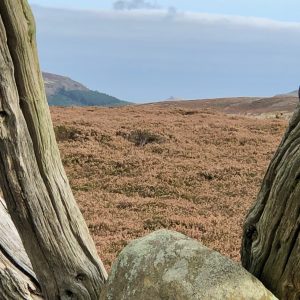Prompted by the mention of Prod Howe a couple of days ago, I chose a revisit today.

In the article referred to, a key rationalisation was the fact that Roseberry could be seen from it, and sure enough the hill was just peeping over the brow of the moor1 Brian A. Smith, Ken W. Grant, Alan A. Walker. Cairns as waymarkers within a proposed prehistoric Scugdale ‘Loop’. Teesside Archaeological Society. Bulletin 18. 2013. Page 28..
I wouldn’t go as far as calling Prod Howe a cairn. It’s just a jumble of largish stones surrounding an 18th-century boundary stone2North York Moors Historic Environment Record (HER) No: 5736. Some of the stones in the jumble have been crudely dressed though, and the whole assembly is on a slight mound, barely prominent to justify a contour line, which I don’t think is sepulchral cairn; certainly I can not find a reference in the Historic Environment Record.
The most distinctive feature of Prod Howe are the three boughs outstretched to the sky in apparent supplication. Bill Cowley includes a sketch in his 1993 book “Snilesworth” of a three-pronged branch but upside down like a tripod3Cowley, Bill. “Snilesworth”. Page 5. Turker Books. 1993.. Cowley suggests this branch must be bog oak perhaps a relic of the pre-historic forest. Apparently the branch was placed in the early 20th-century and hence was locally dubbed “Three Legs“4Ibid. Page 45..
Prod Howe could be said to be the head of a dale called Proddale, but this must have been named under false pretences. Only in its final kilometre before its confluence with the River Rye does it bare any resemblance to a dale. Here Proddale Sike becomes Proddale Beck at an old very boggy enclosure called Proddales, which was listed as a farm-holding in the 17th-century5Ibid. Page 45.. It is a very marshy area for which it is hard to imagine how it could ever have been productive.
In a 13th-century document relating to the determination of the boundaries of Byland abbey, it is thought the name Pundkalehou — in another version written Prubalehou — is a reference to Prod Howe6Ibid. Page 88..
- 1Brian A. Smith, Ken W. Grant, Alan A. Walker. Cairns as waymarkers within a proposed prehistoric Scugdale ‘Loop’. Teesside Archaeological Society. Bulletin 18. 2013. Page 28.
- 2North York Moors Historic Environment Record (HER) No: 5736
- 3Cowley, Bill. “Snilesworth”. Page 5. Turker Books. 1993.
- 4Ibid. Page 45.
- 5Ibid. Page 45.
- 6Ibid. Page 88.

Leave a Reply